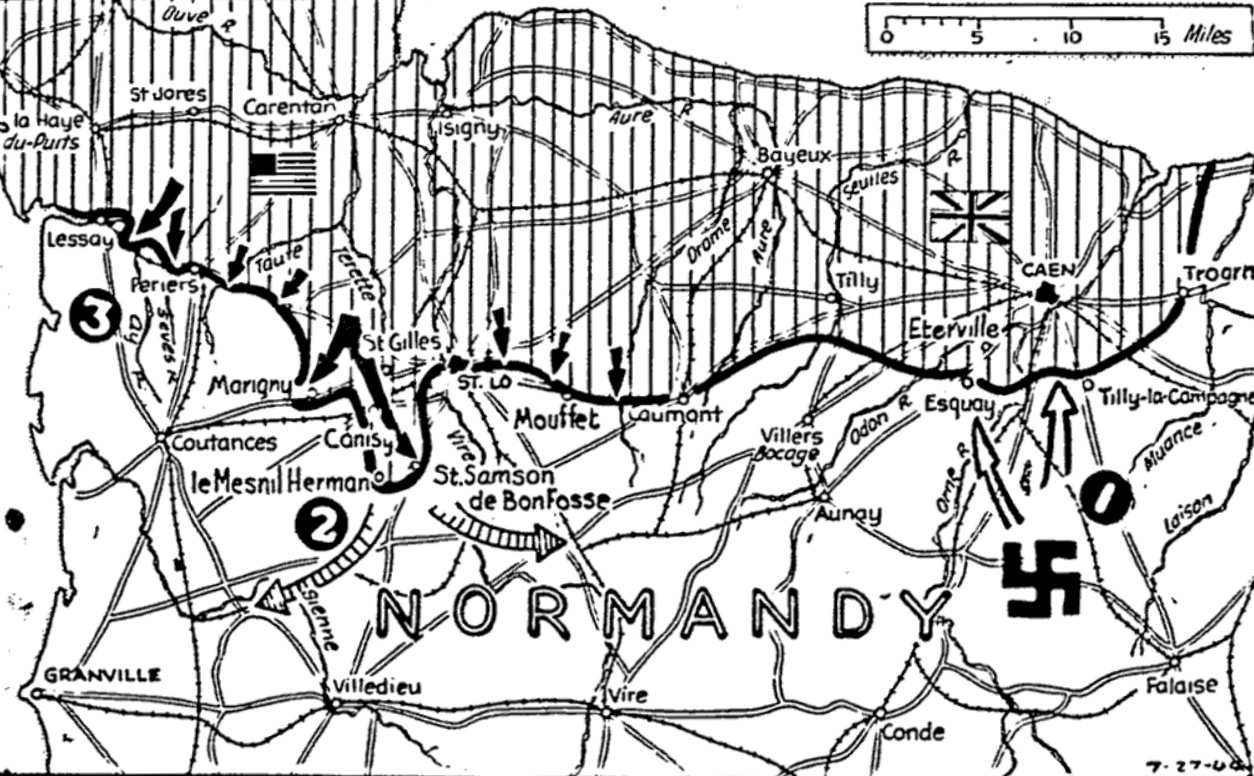Supreme HQ Allied Expeditionary Force (July 27, 1944)
Communiqué No. 103
In the area west of SAINT-LÔ, Allied forces have made good gains through enemy positions. One armored column has driven south some five miles from the PÉRIERS–SAINT-LÔ road to take MARIGNY. Another armored prong thrust across the SAINT-LÔ–COUTANCES road through SAINT-GILLES. The advance is continuing. Elsewhere in the western sector local gains have been made.
South of CAEN, there has been heavy fighting, with the enemy continuing a stubborn defense. All attacks by our forces in this sector have met strong concentrations of enemy tanks, artillery and mortars. Several enemy counterattacks have been repulsed.
Yesterday afternoon and evening, fighter-bombers attacked enemy gun positions, strong points, tank and troop concentrations in and around the battle area.
Other fighter-bombers and fighters kept up the attack on transportation targets over a wide area from DOUAI to VENDOME, cutting railway tracks and strafing locomotives, rolling stock and vehicles.
Sixteen enemy aircraft were shot down. Thirteen of ours are missing.
Fuel dumps at FONTAINEBLEAU and SENONCHES and railway bridges at EPERNON and L’AIGLE were attacked early yesterday evening by medium bombers.
Heavy bombers, six of which are missing, attacked the railway center of GIVORS–BADAN, 12 miles south of LYONS, last night.
Three enemy aircraft were shot down during the night, two over NORMANDY and one by INTRUDERS.
Periodical Communiqué No. 2
271700b July
Since 15 July, the French Forces of the Interior have repelled further attempts by the Germans to liquidate Marquis areas. German attacks have now taken the form of raids carried out by armored columns. In many instances these new tactics have been frustrated by ambushes.
In the SAÔNE-ET-LOIRE Department, resistance forces have succeeded in annihilating an enemy convoy of 116 lorries. In the PYRENEES, resistance forces attacked a column of armored cars and artillery with such success that the enemy was forced to bring up reinforcements in order to avoid complete defeat. Engagements have also taken place in MORVAN and in BRITTANY. In the RHÔNE Valley, resistance forces which have withdrawn from towns captured by the enemy have now regrouped in the woods.
In NORMANDY and elsewhere, attacks against the railway system continue to disorganize the enemy’s lines of communication. In the LOIRET, 30 trucks of war material have been destroyed. In the HÉRAULT, attacks on railway lines have caused several derailments, including the wrecking of an ammunition train. Interruptions of traffic in this area lasted from 18 to 36 hours.
The destruction of locks on important canals has continued, particularly in the north and in the east, thereby interfering with the transport of fuel. Barges carrying 100,000 gallons of oil fuel have been blown up, and petrol depots and convoys have been destroyed in the NIÈVRE.
Communiqué No. 104
Allied armored thrusts in the western sector continue to make rapid progress.
One column has cut the road from SAINT-LÔ to PERCY in the neighborhood of LE MESNIL-HERMAN, while another has advanced for miles to the southwest of CANISY. A third has driven some distance west form MARIGNY down the COUTANCES road.
Between the SEVES and the AY rivers, an advance of some 2,000 yards has cut the PÉRIERS–LESSAY road.
Between SAINT-LÔ and CAUMONT, the enemy salient is being steadily eliminated and advanced troops after occupying BERIGNY have reached the outskirts of NOTRE-DAME-D’ELLE. Other forces moving west from the CAUMONT area have reached the village of MOUFFET.
A strong enemy counterattack towards VERRIÈRES was repulsed last night. The enemy has made no further effort in the CAEN sector.
Fighter-bombers, supporting advancing ground forces in the SAINT-LÔ sector, attacked enemy guns and transport.
Military targets at BRUSSELS and GHENT were attacked by small forces of heavy bombers this morning. Escorting fighters strafed roads and railway facilities in the same area.
Enemy shipping off the PAS-DE-CALAIS coast was attacked by coastal aircraft early today.

